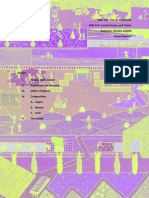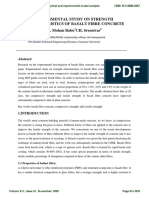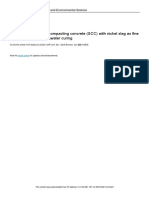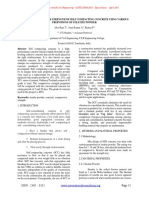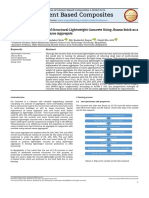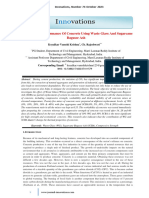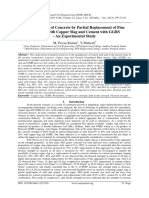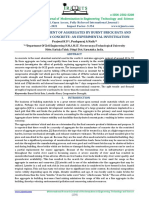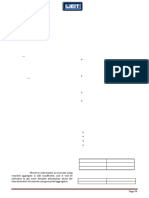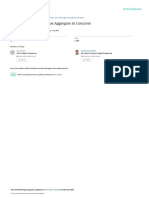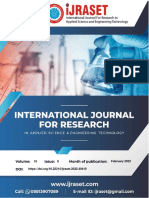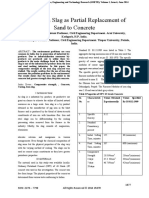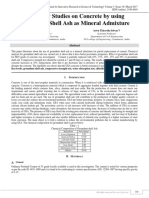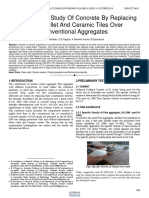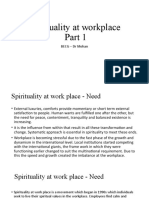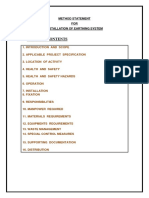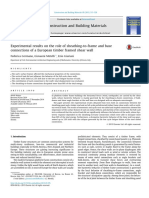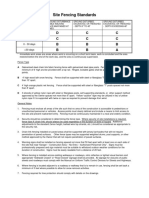Experimental Study On Concrete Using Cement With Glass Powder
Experimental Study On Concrete Using Cement With Glass Powder
Uploaded by
Gowri J BabuCopyright:
Available Formats
Experimental Study On Concrete Using Cement With Glass Powder
Experimental Study On Concrete Using Cement With Glass Powder
Uploaded by
Gowri J BabuOriginal Title
Copyright
Available Formats
Share this document
Did you find this document useful?
Is this content inappropriate?
Copyright:
Available Formats
Experimental Study On Concrete Using Cement With Glass Powder
Experimental Study On Concrete Using Cement With Glass Powder
Uploaded by
Gowri J BabuCopyright:
Available Formats
IOSR Journal of Engineering (IOSRJEN) www.iosrjen.
org
ISSN (e): 2250-3021, ISSN (p): 2278-8719
Vol. 05, Issue 05 (May. 2015), ||V3|| PP 43-53
Experimental Study on Concrete Using Cement With Glass
Powder
T.Subramani1, S.B.Sankar Ram2
1
Professor & Dean, Department of Civil Engineering, VMKV Engg. College, Vinayaka Missions University,
Salem, India
2
PG Student of Structural Engineering, Department of Civil Engineering, VMKV Engg. College,
Vinayaka Missions University, Salem, India
Abstract: - Cement manufacturing industry is one of the carbon dioxide emitting sources besides deforestation
and burning of fossil fuels. The global warming is caused by the emission of green house gases, such as CO2, to
the atmosphere. Among the greenhouse gases, CO2 contributes about 65% of global warming. The global
cement industry contributes about 7% of greenhouse gas emission to the earth’s atmosphere. Glass is used in
many forms in day-to-day life. It has limited life span and after use it is either stock piled or sent to landfills.
Since glass is non-biodegradable, landfills do not provide an environment friendly solution. Hence, there is
strong need to utilize waste glasses. Many efforts have been made to use waste glass in concrete industry as a
replacement of coarse aggregate, fine aggregate and cement. Its performance as a coarse aggregate replacement
has been found to be non-satisfactory because of strength regression and expansion due to alkali-silica reaction.
The research shows that there is strength loss due to fine aggregate substitution also. Efforts have been made in
the concrete industry to use waste glass as partial replacement of coarse or fine aggregates and cement. In this
study, finely powdered waste glasses are used as a partial replacement of cement in concrete and compared it
with conventional concrete. This work examines the possibility of using Glass powder as a partial replacement
of cement for new concrete. Glass powder was partially replaced as 10%, 20%, 30% and 40% and tested for its
compressive, Tensile and flexural strength up to 28 days of age and were compared with those of conventional
concrete; from the results obtained, it is found that glass powder can be used as cement replacement material up
to particle size less than 75μm to prevent alkali silica reaction.
Keywords: Experimental Study, Concrete, Using Cement, Glass Powder
I INTRODUCTION
Concrete is a blend of cement, sand, coarse aggregate and water. The key factor that adds value to
concrete is that it can be designed to withstand harshest environments significant role. Today global warming
and environmental devastation have become manifest harms in recent years, concern about environmental
issues, and a changeover from the mass-waste, mass-consumption, mass-production society of the past to a zero-
emanation society is now viewed as significant. Normally glass does not harm the environment in any way
because it does not give off pollutants, but it can harm humans as well as animals, if not dealt carefully and it is
less friendly to environment because it is non-biodegradable. Thus, the development of new technologies has
been required. The term glass contains several chemical diversities including soda-lime silicate glass, alkali-
silicate glass and boro-silicate glass. To date, these types of glasses glass powder have been widely used in
cement and aggregate mixture as pozzolana for civil works. The introduction of waste glass in cement will
increase the alkali content in the cement. It also help in bricks and ceramic manufacture and it preserves raw
materials, decreases energy consumption and volume of waste sent to landfill. As useful recycled materials,
glasses and glass powder are mainly used in fields related to civil engineering, for example, in cement, as
pozzolana(supplementary cementitious materials), and coarse aggregate. Their recycling ratio is close to 100%,
and it is also used in concrete without adverse effects in concrete durability. Therefore, it is considered ideal for
recycling Recently, Glasses and its powder has been used as a construction material to decrease environmental
problems. The coarse and fine glass aggregates could cause ASR(alkali-silica reaction) in concrete , but the
glass powder could suppress their ASR tendency, an effect similar to supplementary cementations materials
(SCMs). Therefore, glass is used as a replacement of supplementary cementitious materials.
II MATERIALS USED
In this project waste materials were utilized to produce building bricks. The following materials were used in
this investigation
International organization of Scientific Research 43 | P a g e
Experimental Study on Concrete Using Cement With Glass Powder
2.1 Cement
Cement is one of the binding materials in this project. Cement is the important building material in
today’s construction world 53 grade Ordinary Portland Cement (OPC) conforming to IS: 8112-1989. Table 3.1
gives the properties of cement used.
Table 2.1: Properties of cement
Test results
Description of test Requirements
obtained
of IS: 8112 1989
Initial setting time 65 minutes Min. 30minutes
Final setting time 270 minutes Max. 600minutes
Fineness (specific
412.92
surface by Blaine’s Min. 225 m2/kg
m2/kg
air permeability test)
Figure. 2.1 Cement
Ordinary Portland cement, 53Grade conforming to IS: 269 – 1976.Ordinary Portland cement,
53Gradewas used for casting all the Specimens. Different types of cement have different water requirements to
produce pastes of standard consistence. Different types of cement also will produce concrete have a different
rates of strength development. The choice of brand and type of cement is the most important to produce a good
quality of concrete. The type of cement affects the rate of hydration, so that the strengths at early ages can be
considerably influenced by the particular cement used. It is also important to ensure compatibility of the
chemical and mineral admixtures with cement.
2.2 Fine Aggregate
Locally available river sand conforming to Grading zone II of IS: 383 –1970. Clean and dry river sand
available locally will be used. Sand passing through IS 4.75mm Sieve will be used for casting all the
specimens.(Fig.2.2 and Table 2.2)
Table 2.2 Property Of Fine Aggregate
S.NO PROPERTIES VALUE
1 Specific Gravity 2.65
2 Fineness Modulus 2.25
3 Water absorption 1.5%
Fig 2.2 Fine Aggregate
Locally available river sand conforming to Grading zone I of IS: 383 –1970.Clean and dry river sand available
locally will be used. Sand passing through IS 4.75mm Sieve will be used for casting all the specimens.
International organization of Scientific Research 44 | P a g e
Experimental Study on Concrete Using Cement With Glass Powder
2.3 Coarse Aggregate
Table 2.3 Property Of Coarse Aggregate
VALUES
S.NO PROPERTIY
1 Specific Gravity 2.68
2 Size Of Aggregates 20mm
3 Fineness Modulus 5.96
4 Water absorption 2.0%
5 Impact Test 15.2%
6 Crushing Test 22.5%
Fig 2.3 Coarse Aggregate
Crushed granite aggregate with specific gravity of 2.77 and passing through 4.75 mm sieve and will be
used for casting all specimens. Several investigations concluded that maximum size of coarse aggregate should
be restricted in strength of the composite. In addition to cement paste – aggregate ratio, aggregate type has a
great influence on concrete dimensional stability. Locally available crushed blue granite stones conforming to
graded aggregate of nominal size 20 mm as per IS: 383 – 1970.Crushed granite aggregate with specific gravity
of 2.77 and passing through 4.75 mm sieve and will be used for casting all specimens. Several investigations
concluded that maximum size of coarse aggregate should be restricted in strength of the composite. In addition
to cement paste – aggregate ratio, aggregate type has a great influence on concrete dimensional stability.
(Fig.2.3 & Table 2.3)
2.4 Water
Casting and curing of specimens were done with the potable water that is available in the college premises.
2.5 Glass Powder
Glass powder is finely ground glass. These fine glass particles
remind you of talcum powder. Use extreme care when handling this dry powder pigment to prevent breathing
the dust particles. Make sure you wear a respiratory mask when working with this powder, preferably one that is
NIOSH approved. Check to see that the powder has the same COE as your other fusing glass. This will
ensure that your projects will not have built up stress. Powder glass is so versatile and useful. It can be
purchased in every color of the rainbow. Glass is a rigid liquid i.e. super cooled liquid, static, not solid, not a
gas but does not change molecularly between melting and solidification in to a desired shape. Glass is one of the
most versatile substances on earth used in many applications and in a wide variety of forms. Glass occurs
naturally when rock high in silicates melt at high temperature and cool before they can form a crystalline
structure. Obsidian or volcanic glass is a well known example of naturally occurring glass. When manufactured
by human's the glass is a mixture of silica, sand, lime and other materials. The elements of glass are heated to
9820 Celsius. eat can return the glass to a liquid and workable form, making it easy to reuse and recycle.
(Fig.2.4)
Fig 2.4 Glass powder
International organization of Scientific Research 45 | P a g e
Experimental Study on Concrete Using Cement With Glass Powder
III MATERIAL CHARACTERISTICS
3.1 CEMENT:
The type of cement used was Portland Pozzalona Cement.
3.1.1specific Gravity
The density bottle was used to determine the specific gravity of cement. The bottle was cleaned and
dried. The weight of empty bottle with brass cap and washerW 1 was taken. Then bottle was filled by 200 to
400g of dry cement and weighed as W 2.The bottle was filled with kerosene and stirred thoroughly for removing
the entrapped air which was weighed as W3.It was emptied, cleaned well, filled with kerosene and weighed as
W 4.
Specific gravity of Cement (G) = (W 2-W1)
(W2-W1) - (W3-W4)
W1 = Weight of empty density bottle with brass cap and washer in gm.
W2 = Mass of the density bottle & cement in gm.
W3 = Mass of the density bottle, cement & kerosene in gm.
W4 = Mass of the density bottle filled with kerosene in gm.
3.1.2 Fineness (By Sieve Analysis)
The fineness of cement has an important bearing on the rate of hydration and hence on the rate of gain
of strength and also on the rate of evolution of heat. Finer cement offers a greater surface area for hydration and
hence faster development of strength. 100 grams of cement was taken on a standard IS SieveNo.9(90 microns).
The air-set lumps in the sample were broken with fingers. The sample was continuously sieved giving circular
and vertical motion for 15 minutes. The residue left on the sieve was weighed.
3.1.3 Consistency
The objective of conducting this test is to find out the amount of water to be added to the cement to get
a paste of normal consistency. 500 grams of cement was taken and made into a paste with a weighed quantity of
water (% by weight of cement) for the first trial. The paste was prepared in a standard manner and filled into the
vicat mould plunger, 10mm diameter, 50mm long and was attached and brought down to touch the surface of
the paste in the test block and quickly released allowing it to sink into the paste by its own weight. The depth of
penetration of the plunger was noted. Similarly trials were conducted with higher water cement ratios till such
time the plunger penetrates for a depth of 33-35mm from the top. That particular percentage of water which
allows the plunger to penetrate only to a depth of 33-35mm from the top is known as the percentage of water
required to produce a cement paste of standard consistency.
3.1.4 Initial Setting Time
The needle of the Vicat apparatus was lowed gently and brought in contact with the surface of the test
block and quickly released. It was allowed to penetrate into the test block. In the beginning, the needle
completely pierced through the test block. But after sometime when the paste starts losing its plasticity, the
needle penetrated only to a depth of 33-35mm from the top. The period elapsing between the time when water is
added to the cement and the time at which the needle penetrates the test block to a depth equal to 33-35mm from
the top was taken as the initial setting time.
3.2 Coarse Aggregate
20mm down size aggregate was used.
3.2.1 Specific Gravity
A pycnometer was used to find out the specific gravity of coarse aggregate. The empty dry pycnometer was
weighed and taken as W1. Then the pycnometer is filled with 2/3 of coarse aggregate and it was weighed as W2.
Then the pycnometer was filled with part of coarse aggregate and water and it weighed as W 3. The pycnometer
was filled up to the top of the bottle with water and weighed it as W 4.
Specific gravity of Cement (G) = (W2-W1)
(W2-W1) - (W3-W4)
W1 = Mass of empty pycnometer in gm.
W2 = Mass of pycnometer& coarse
aggregate in gm.
International organization of Scientific Research 46 | P a g e
Experimental Study on Concrete Using Cement With Glass Powder
W3 = Mass of the pycnometer, coarse aggregate & water in gm.
W4 = Mass of the pycnometer filled with water in gm.
3.2.2 Bulk Density
Bulk density is the weight of a material in a given volume. It is expressed in Kg/m 3.A cylindrical
measure of nominal diameter 250mm and height 300mm was used. The cylinder has the capacity of 1.5 liters
with the thickness of 4mm. The cylindrical measure was filled about 1/3 each time with thoroughly mixed
aggregate and tampered with 25 strokes. The measure was carefully struck off level using tamping rod as
straight edge. The net weight of aggregate in the measure was determined. Bulk density was calculated as
follows.
Bulk density = (Net weight of coarse aggregate in Kg)/ (Volume)
3.2.3 Surface Moisture
100g of coarse aggregate was taken and their weight was determined, say W1. The sample was then kept in the
oven for 24 hours. It was then taken out and the dry weight is determined, says W 2. The difference between W1
and W2 gives the surface moisture of the sample.
3.2.4 Water Absorption
100g of nominal coarse aggregate was taken and their weight was determined, say W 1. The sample was
then immersed in water for 24 hours. It was then taken out, drained and its weight was determined, says W 2. The
difference between W1 and W2 gives the water absorption of the sample.
3.2.5 Fineness Modulus
The sample was brought to an air-dry condition by drying at room temperature. The required quantity
of the sample was taken (3Kg). Sieving was done for 10 minutes. The material retained on each sieve after
shaking, represents the fraction of the aggregate coarser then the sieve considered and finer than the sieve above.
The weight of aggregate retained in each sieve was measured and converted to a total sample. Fineness modulus
was determined as the ratio of summation of cumulative percentage weight retained (F) to 100.
3.3 Properties Of Water
Water used for mixing and curing shall be clean and free from injurious amounts of Oils, Acids, Alkalis, Salts,
Sugar, Organic materials Potable water is generally considered satisfactory for mixing concrete Mixing and
curing with sea water shall not be permitted. The pH value shall not be less than 6.
3.4 Properties Of Glass Powder
Properties Of Glass Powder given in Table 3.1 and Chemical composition of glass powder shown in Fig.3.1
Table 3.1 Properties Of Glass Powder
Composition (% by mass)/
Glass powder
property
Silica (SiO2) 72.5
Alumina (Al2O3) 0.4
Iron oxide (Fe2O3) 0.2
Calcium oxide (CaO) 9.7
Magnesium oxide (MgO) 3.3
Sodium oxide (Na2O) 13.7
Potassium oxide (K2O) 0.1
Sulphur trioxide (SO3) -
Loss of ignition 0.36
Fineness % passing (sieve size) 80 (45 µm)
Unit weight,Kg/m3 2579
Specific gravity 2.58
Figure 2.5 Chemical composition of glass powder
International organization of Scientific Research 47 | P a g e
Experimental Study on Concrete Using Cement With Glass Powder
3.5 Fresh Concrete Properties
3.5.1. Workability
With the addition of furnace slag, the slump loss with time is directly proportional to increase in the
slag content due to the introduction of large surface area in the concrete mix by its addition. Although the slump
decreases, the mix remains highly cohesive.
3.5.2 Segregation And Bleeding
Furnace slag reduces bleeding significantly because the free water is consumed in wetting of the large surface
area of the furnace slag and hence the free water left in the mix for bleeding also decreases. Furnace slag also
blocks the pores in the fresh concrete so water within the concrete is not allowed to come to the surface.
3.5.3 Slump Test
Fresh concrete when unsupported will flow to the sides and sinking in height will take place. This vertical
settlement is known as slump.(Fig.3.2 and Table 3.2)
The workability (ease of mixing, transporting, placing and compaction) of concrete depends on wetness of
concrete (consistency) i.e., water content as well as proportions of fine aggregate to coarse aggregate and
aggregate to cement ratio.
The slump test which is a field test is only an approximate measure of consistency defining ranges of
consistency for most practical works. This test is performed by filling fresh concrete in the mould and
measure the settlement i.e., slump.
Table 3.2 Slump Result
Ratio Slump value
Conventional Concrete
Control mix 25.5mm
Slag Concrete M25
Ratio I 25.65mm
Ratio II 26. 20mm
Ratio III 26.50 mm
Figure. 3.2 Slump Test
3.6 Hardened Concrete Properties
3.6.1 Compression Test On Concrete Cubes
The determination of the compressive strength of concrete is very important because the compressive
strength is the criterion of its quality. Other strength is generally prescribed in terms of compressive strength.
The strength is expressed in N/mm2. This method is applicable to the making of preliminary compression tests
to ascertain the suitability of the available materials or to determine suitable mix proportions. The concrete to be
tested should not have the nominal maximum size of aggregate more than 20mm test specimens are either 15cm
cubes or 15cm diameter used. At least three specimens should be made available for testing. Where every
cylinder is used for compressive strength results the cube strength can be calculated as under.Minimum cylinder
compressive strength = 0.8 x compressive strength cube (10 cm x 10 cm) The concrete specimens are generally
tested at ages 7 days and 28 days.
3.6.2 Split Tensile Test On Cylinder
Concrete is strong in compression but weak in tension. Tension stresses are likely to develop in
concrete due to drying shrinkage, rusting of reinforcement, temperature gradient etc.
In concrete road slab this tensile stresses are developed due to wheel loaded and volume changes in concrete are
available to determine this. Split test is one of the indirect methods available to find out the tensile strength.
3.6.3 Flexural Test On Beams
It is the ability of a beam or slab to resist failure in bending. It is measured by loading un-reinforced
6x6 inch concrete beams with a span three times the depth (usually 18 in.). The flexural strength is expressed as
“Modulus of Rupture” (MR) in psi. Flexural MR is about 12 to 20 percent of compressive strength.
International organization of Scientific Research 48 | P a g e
Experimental Study on Concrete Using Cement With Glass Powder
IV MIX DESIGN
4.1 Definition
Mix design is the process of selecting suitable ingredient if concrete and determines their relative proportions
with the object of certain minimum strength and durability as economically as possible.
4.2 Objective Of Mix Design
The objective of concrete mix design as follows.
The first objective is to achieve the stipulated minimum strength.
The second objective is to make the concrete in the most economical Manner. Cost wise all concrete’s
depends primarily on two factors, namely cost of material and cost of labour. Labor cost, by way of
formwork, batching, mixing, transporting and curing is namely same for good concrete.
4.3 Factors To Be Considered In Mix Design
1. Grade of concrete
2. Type of cement
3. Type & size of aggregate
4. Type of mixing & curing
5. Water /cement ratio
6. Degree of workability
7. Density of concrete
8. Air content
V TESTING PROCEDURE
5.1 General Procedure
Within the experimental research program concerning the development of mechanical properties of a
partially replacement of cement by flyash, partially replacement of sand by bottom ash and glass is used
reference concrete of grade M25 (REF) was considered with the following composition, accordingly. The w/c-
ratio is 0.43. Coarse aggregates were chosen, having a particle size mainly varying between 2 mm and 20 mm.
An intensive experimental program is performed to study the effect of internal curing on different types of
concrete properties: (i) fresh properties (slump and density); (ii) mechanical properties (compressive strength,
flexural strength, splitting tensile strength).
5.2 Compressive Strength Test
When a specimen of material is loaded in such a way that it extends it is said to be in tension. On the
other hand if the material compresses and shortens it is said to be in compression.
On an atomic level, the molecules or atoms are forced apart when in tension whereas in compression
they are forced together. Since atoms in solids always try to find an equilibrium position, and distance between
other atoms, forces arise throughout the entire material which oppose both tension or compression. The
phenomena prevailing on an atomic level are therefore similar.The "strain" is the relative change in length under
applied stress; positive strain characterises an object under tension load which tends to lengthen it, and a
compressive stress that shortens an object gives negative strain. Tension tends to pull small sideways deflections
back into alignment, while compression tends to amplify such deflection into buckling.Compressive strength is
measured on materials, components, and structures. By definition, the ultimate compressive strength of a
material is that value of uniaxial compressive stress reached when the material fails completely. The
compressive strength is usually obtained experimentally by means of a compressive test. The apparatus used for
this experiment is the same as that used in a tensile test. However, rather than applying a uniaxial tensile load, a
uniaxial compressive load is applied. As can be imagined, the specimen (usually cylindrical) is shortened as
well as spread laterally. In the study of strength of materials, the compressive strength is the capacity of a
material or structure to withstand loads tending to reduce size. It can be measured by plotting applied force
against deformation in a testing machine. Some materials fracture at their compressive strength limit; others
deform irreversibly, so a given amount of deformation may be considered as the limit for compressive load.
Compressive strength is a key value for design of structuresAt the time of testing, each specimen must keep in
compressive testing machine. The maximum load at the breakage of concrete block will be noted. From the
noted values, the compressive strength may calculated by using below formula.(Fig.5.1)
Compressive Strength = Load / Area
Size of the test specimen=150mm x 150mm x 150mm
International organization of Scientific Research 49 | P a g e
Experimental Study on Concrete Using Cement With Glass Powder
Fig 5.1 Compression Test Fig 5.2 Split Tensile Test
5.3 Split Tensile Test
• The size of cylinders 300 mm length and 150 mm diameter are placed in the machine such that load is
applied on the opposite side of the cubes are casted. Align carefully and load is applied, till the specimen breaks.
The formula used for calculation. (Fig.5.2)
Split tensile strength = 2P/ µdl
5.4 Flexural Strength Test
During the testing, the beam specimens of size 7000mmx150mmx150mm were used. Specimens were
dried in open air after 7 days of curing and subjected to flexural strength test under flexural testing assembly.
Apply the load at a rate that constantly increases the maximum stress until rupture occurs. The fracture indicates
in the tension surface within the middle third of span length.
VI TEST RESULTS
6.1 Ratios For Concrete (Extra Ingredients)
Various Percentange Of Glass Powder
RATIO –I
Glass powder – 10 % by replacement of Cement
RATIO - II
Glass powder – 20 % by replacement of Cement
RATIO - III
Glass powder – 30 % by replacement of Cement
RATIO - IV
Glass powder – 40 % by replacement of Cement
6.2 Compressive Strength Of Concrete
The Table 6.1,6,2 & 6.3 shows the strength gain at various percentages of glass powder replacement at
7, 14 & 28th day. It can be seen clearly that there a reduction in the strength at the 10% replacement. Waste
glass when ground to a very fine powder, SiO2 react chemically with alkalis in cement and form cementitious
product that help contribute to the strength development. Also it may be due to the glass powder effectively
filling the voids and giving rise to a dense concrete. When comparing the strength gain with the cement mortar
strength gain it can be seen that there is increment of strength even at 10% glass powder replacement. This must
be due to the dilution effect takes over and the strength starts to drop . The presents of excess glass powder
without necessary calcium to react, forms weak pockets in the concrete that reduces the concrete strength, this
happens due to alkali silicate reaction
International organization of Scientific Research 50 | P a g e
Experimental Study on Concrete Using Cement With Glass Powder
Table 6.1 Compressive Test on Cube for 7 days Table 6.2 Compressive Test On Cube For 14 Days
Compressive Strength In N/Mm2 7 Compressive Strength In N/Mm2
Days 14 Days
Con Contro
trol Various % Of Glass Powder Various % Of Glass Powder
l Mix
Mix Cc Cc 10
(0% 10 20 30 (0%) 20% 30% 40%
) 40% %
% % %
M25 8.23 9.20 9.03 8.96 8.52 19.7
M 25 20.2 19.6 19.14 18.8
6
Table 6.3 Compressive Test On Cube For 28 days
Control Compressive Strength In N/Mm2 28 Days
Mix Various % Of Glass Powder
Cc (0%) 10% 20% 30% 40%
M25 23.6 23.95 22.6 21.4 20.9
6.3 Split Tensile Strength Of Concrete
The Table 6.4, Table 6.5 and Table 6.6 Shows The Split Tensile Test On Cylinder For 7 Days, 14 Days & 28
Days of glass powder replacement at 28th day. It can be seen clearly that there a reduction in the strength at the
40 % replacement. The split tensile strength is improvement is marginal compared to the compressive strength
increase.
Table 6.4 Split Tensile Test On Cylinder for 7 days Table 6.5 Split Tensile Test On Cylinder for 14 days
Split tensile Strength in N/mm2 7
DAYS Split tensile Strength in N/mm2 14
Control Control
Various % of glass powder days
Mix Mix
CC Various % of glass powder
(0%) 10% 20% 30% 40% CC (0%)
10% 20% 30% 40%
M25 1.98 2.26 2.15 2.08 1.84 2.35 2.67 2.54 2.32 2.14
M25
Table 6.6 Split Tensile Test On Cylinder for 28 days
Control Split tensile Strength in N/mm2 28 days
Mix Various % of glass powder
CC (0%) 10% 20% 30% 40%
M25 3.04 3.28 3.02 2.98 2.84
6.4 Flexural Strength Of Concrete
The Table 6.7, Table 6.8 and Table 6.9 Shows flexural strength improvement at various percentages of
glass powder replacement For 7 Days, 14 Days & 28 Days It can be seen clearly that there a reduction in the
strength at the 40% replacement here also. The flexural strength improves considerably at 10 % replacement
which is about 43 % compared to the control specimen.
International organization of Scientific Research 51 | P a g e
Experimental Study on Concrete Using Cement With Glass Powder
Table 6.7 Flexural Test On Beam For 7 days Table 6.8 Flexural Test On Beam for 14 days
Flexural Strength In N/mm2 14
Flexural Strength In N/mm2
DAYS
7 DAYS Contr
Control ol Mix Various % of glass powder
Various % of glass
Mix CC (
CC powder
0% ) 10 20% 30% 40%
( 10% 20% 30% 40% %
0%
)
M25 6.2 6.42 6.15 6.08 5.94
M25 5.2 5.64 5.42 5.36 5.18
Table 6.9 Flexural Test On Beam for 28 days
Flexural Strength In N/mm2 28 DAYS
Control Mix
Various % of glass powder
CC ( 0% )
10% 20% 30% 40%
M25 6.8 7.15 7.06 6.95 6.76
VII CONCLUSION
Based on experimental observations, the following conclusions are drawn.
1. The compressive strength of concrete cube up to a replacement proportion of 10% of cement.
2. In case of cement mortar the strength improves up to 15% replacement of cement.
3. There was marginal improvement in the Split tensile strength
4. A considerable improvement in the flexural strength was seen at 10% replacement of cement.
5. It can be concluded form the above result that 10% replacement of cement by glass powder is the best
proportion.
6. Alkali-silica reactivity effect is controlled when glass powder with high Na2O is used.
7. Further investigation can be done by using plasticizers to improve the workability and strength. Also
durability investigation can be done to see the long term effect of glass powder replacement.
REFERENCES
[1]. Thanongsak, N., Watcharapong, W., and Chaipanich. A., (2009), “Utilization of fly ash with silica fume
and properties of Portland cement-fly ash-silica fume concrete”. Fuel, Volume 89, Issue 3, March 2010,
Pages 768-774.
[2]. Patel, A, Singh, S.P, Murmoo, M. (2009), “Evaluation of strength characteristics of steel slag hydrated
matrix” Proceedings of Civil Engineering Conference-Innovation without limits (CEC-09), 18th - 19th
September‟ 2009.
[3]. Li Yun-feng, Yao Yan, Wang Ling, “Recycling of industrial waste and performance of steel slag green
concrete”, J. Cent. South Univ. Technol.(2009) 16: 8−0773, DOI: 10.1007/s11771-009-0128-x.
[4]. Velosa, A.L, and Cachim, P.B.,” Hydraulic lime based concrete: Strength development using a pozzolanic
addition and different curing conditions” ,Construction and Building Materials
,Vol.23,Issue5,May2009,pp.2107-2111.
[5]. Gonen,T. and Yazicioglu,S. “ The influence of mineral admixtures on the short and long term
performances of concrete” department of construction education, Firat University, Elazig 23119,
Turkey.2009.
[6]. Mateusz R.J. O. and Tommy N. “ Effect of composition and Initial Curing Conditions of Scaling
Resistance of Ternary(OPC/FA/SF) concrete”, Journal of Materials in Civil Engineering © ASCE/October
2008, PP 668-677. 37
International organization of Scientific Research 52 | P a g e
Experimental Study on Concrete Using Cement With Glass Powder
[7]. Chang-long,W QI, Yan-ming,He Jin-yun, “Experimental Study on Steel Slag and Slag Replacing Sand in
Concrete”, 2008, International Workshop on Modelling, Simulation and Optimization.
[8]. Jigar P. Patel, “Broader use of steel slag aggregates in concrete”, M.Tech.thesis, Cleveland State
University, December, 2008.
[9]. Subramani, T. “Experimental Investigations on Coir Fibre Reinforced Bituminous Mixes” International
Journal of Engineering Research and Applications, Vol.2, Issue.3, pp 1794-1804, 2012.
[10]. Subramani,T, Krishnan.S. And Kumaresan.P.K., Study on Exixting Traffic condition in Salem City and
Identify the transport facility improvement projects, International Journal of Applied Engineering
Research IJAER, Vol.7,No.7, Pp 717 – 726, 2012.
[11]. Subramani.T, Sharmila.S, “Prediction of Deflection and Stresses of Laminated Composite Plate with
Artificial Neural Network Aid”, International Journal of Modern Engineering Research, Volume 4, Issue 6
(Version 1), pp 51 -58, 2014.
[12]. Subramani.T, Senthilkumar.T, Jayalakshmi.J, "Analysis Of Admixtures And Their Effects Of Silica
Fumes, Metakaolin And Pfa On The Air Content",International Journal of Modern Engineering Research,
Volume 4, Issue 6 (Version 4), pp 28-36, 2014.
[13]. Subramani.T, Sakthi Kumar.D, Badrinarayanan.S "Fem Modelling And Analysis Of Reinforced Concrete
Section With Light Weight Blocks Infill " International Journal of Engineering Research and Applications,
Volume. 4, Issue. 6 (Version 6), pp 142 - 149, 2014.
AUTHOR
Prof. Dr.T.Subramani Working as a Professor and Dean of Civil Engineering in VMKV
Engg. College, Vinayaka Missions University, Salem, Tamilnadu, India. Having more than
25 years of Teaching experience in Various Engineering Colleges. He is a Chartered Civil
Engineer and Approved Valuer for many banks. Chairman and Member in Board of Studies
of Civil Engineering branch. Question paper setter and Valuer for UG and PG Courses of
Civil Engineering in number of Universities. Life Fellow in Institution of Engineers (India)
and Institution of Valuers. Life member in number of Technical Societies and Educational
bodies. Guided more than 400 students in UG projects and 150 students in PG projects. He is
a reviewer for number of International Journals and published 102 International Journal Publications and
presented more than 25 papers in International Conferences.
S.B.Sankar Ram completed his Diploma in Civil Engineering in 1980 and AMIE in the
branch of Civil Engineering in 1997. Now, he is working as a Assistant Executive Engineer
in Rural development and Panchayat Raj Department of Government of Tamilnadu.
Currently he is doing ME Degree in the branch of Structural Engineering in the Division of
Civil Engineering,VMKV Engineering College,Salem.
International organization of Scientific Research 53 | P a g e
You might also like
- QCP - Concrete WorksDocument3 pagesQCP - Concrete WorksMitendra Kumar Chauhan100% (1)
- Parc de La Villette Rem KoolhaasDocument7 pagesParc de La Villette Rem KoolhaasAnonymous Psi9GaNo ratings yet
- Hypervisor PDFDocument7 pagesHypervisor PDFGowri J BabuNo ratings yet
- Study On The Strength of Glass Fiber Reinforcement Concrete With Fragmentary ReplacementDocument6 pagesStudy On The Strength of Glass Fiber Reinforcement Concrete With Fragmentary ReplacementIJRASETPublicationsNo ratings yet
- Reuse of Ceramic Waste As Aggregate in Concrete PDFDocument5 pagesReuse of Ceramic Waste As Aggregate in Concrete PDFprotenelllyNo ratings yet
- A Comparative Study On Mechanical Properties of SCC by Partial Replacement of Cement With Fly Ash & Ggbs With The Use of Glass FibersDocument5 pagesA Comparative Study On Mechanical Properties of SCC by Partial Replacement of Cement With Fly Ash & Ggbs With The Use of Glass FibersLavanya GanesanNo ratings yet
- Paper 274Document9 pagesPaper 274FikeduNo ratings yet
- A Study On Glass Powder Waste As Partial Replacement of Cement For Sustainable DevelopmentDocument11 pagesA Study On Glass Powder Waste As Partial Replacement of Cement For Sustainable DevelopmentHarsh ChordiyaNo ratings yet
- Ijciet 08 04 196Document9 pagesIjciet 08 04 196GOKULKATHIR.H II YEAR CIVILNo ratings yet
- IJRPR6508 (1)Document5 pagesIJRPR6508 (1)AyuNo ratings yet
- IJETR033435Document6 pagesIJETR033435erpublicationNo ratings yet
- 133 Ijaema November 2020Document11 pages133 Ijaema November 2020Dharma banothuNo ratings yet
- Paper After Corrections 1 FinalllDocument14 pagesPaper After Corrections 1 Finalllsiva 17No ratings yet
- The International Journal of Science & TechnoledgeDocument7 pagesThe International Journal of Science & TechnoledgescegtsNo ratings yet
- The Behaviour of Self-Compacting Concrete (SCC) With Nickel Slag As Fine Aggregate Towards Seawater CuringDocument10 pagesThe Behaviour of Self-Compacting Concrete (SCC) With Nickel Slag As Fine Aggregate Towards Seawater CuringYudhi Dwi HartonoNo ratings yet
- Study On Compressive Strength of Self Compacting Concrete Using Various Propotions of Steatite PowderDocument5 pagesStudy On Compressive Strength of Self Compacting Concrete Using Various Propotions of Steatite PowderBharath BharathNo ratings yet
- Experimental Investigation of Self Compacting Concrete by Partially Replacing Fine Aggregate With Quartz Sand With Use of Recron FibreDocument6 pagesExperimental Investigation of Self Compacting Concrete by Partially Replacing Fine Aggregate With Quartz Sand With Use of Recron Fibreshivanand hippargaNo ratings yet
- Characteristic Strength of Concrete Using Steel Slag As A Fine AggregateDocument8 pagesCharacteristic Strength of Concrete Using Steel Slag As A Fine AggregateIJRASETPublicationsNo ratings yet
- Effect of Quarry Dust As Partial Replacement of Sand in ConcreteDocument9 pagesEffect of Quarry Dust As Partial Replacement of Sand in ConcreteSuman VarmaNo ratings yet
- G0707043944Document6 pagesG0707043944Atul HonaleNo ratings yet
- Experimental Investigation of Silica Fume Based Concrete of M25 GradeDocument7 pagesExperimental Investigation of Silica Fume Based Concrete of M25 GradeIJRASETPublicationsNo ratings yet
- Study On Fly Ash Based Interlocking Concrete PaverDocument9 pagesStudy On Fly Ash Based Interlocking Concrete Pavern8091908No ratings yet
- A Study On Self-Compacting Concrete by Partial Replacement of Cement With Silica Fume and Ground-Granulated Blast-Furnace Slag (Ggbs or GGBFS)Document5 pagesA Study On Self-Compacting Concrete by Partial Replacement of Cement With Silica Fume and Ground-Granulated Blast-Furnace Slag (Ggbs or GGBFS)SanthoshkumarNo ratings yet
- Materials Today: Proceedings: K. Naveen Kumar, D.S. Vijayan, R. Divahar, R. Abirami, C. NivethaDocument5 pagesMaterials Today: Proceedings: K. Naveen Kumar, D.S. Vijayan, R. Divahar, R. Abirami, C. NivethaAnandha SuthanNo ratings yet
- Cebacom 2022 676Document4 pagesCebacom 2022 676Asif KhanNo ratings yet
- An Investigation On The Effect of Partial Replacement of Cement by Zeolite On The Properties of ConcreteDocument5 pagesAn Investigation On The Effect of Partial Replacement of Cement by Zeolite On The Properties of ConcreteAnonymous kw8Yrp0R5rNo ratings yet
- Glass Powder As Fine Aggregate in High Strength ConcreteDocument3 pagesGlass Powder As Fine Aggregate in High Strength ConcreteBhagwatNo ratings yet
- Study On The Performance of Concrete Using Waste Glass and Sugarcane Bagasse AshDocument8 pagesStudy On The Performance of Concrete Using Waste Glass and Sugarcane Bagasse AshDharma banothuNo ratings yet
- IJEDR1802132Document5 pagesIJEDR1802132ayat arahmanNo ratings yet
- Coconut Shell As Partial Replacement of Coarse Aggregate in ConcreteDocument4 pagesCoconut Shell As Partial Replacement of Coarse Aggregate in ConcreteGelo LibanNo ratings yet
- The Behaviour of Concrete by Partial Replacement of Fine Aggregate With Copper Slag and Cement With GGBS - An Experimental StudyDocument6 pagesThe Behaviour of Concrete by Partial Replacement of Fine Aggregate With Copper Slag and Cement With GGBS - An Experimental StudyBijay Krishna DasNo ratings yet
- Partial Replacement of Aggregates by Burnt Brick Bats and Lateritic Fines in Concrete - An Experimental InvestigationDocument10 pagesPartial Replacement of Aggregates by Burnt Brick Bats and Lateritic Fines in Concrete - An Experimental InvestigationIRJMETS JOURNALNo ratings yet
- Experimental Study On Light Weight Concrete Using Coconut Shell and Fly AshDocument9 pagesExperimental Study On Light Weight Concrete Using Coconut Shell and Fly AshIJRASETPublicationsNo ratings yet
- An Experimental Investigation On Steel Fiber Reinforced Concrete With Partial Replacement of Natural Sand by M-SandDocument7 pagesAn Experimental Investigation On Steel Fiber Reinforced Concrete With Partial Replacement of Natural Sand by M-SandAnonymous kw8Yrp0R5rNo ratings yet
- Partial Replacement of Sand With Sawdust in ConcreteDocument4 pagesPartial Replacement of Sand With Sawdust in Concrete18TPCV008 DONA RENJITHNo ratings yet
- Experimental Study On Self-Healing Concrete Using GGBS and MetakaolinDocument9 pagesExperimental Study On Self-Healing Concrete Using GGBS and MetakaolinIJRASETPublicationsNo ratings yet
- An_Experimental_Study_on_Pervious_ConcreteDocument7 pagesAn_Experimental_Study_on_Pervious_ConcretebollywumNo ratings yet
- Effect of Water Cement Ratio On The Work PDFDocument8 pagesEffect of Water Cement Ratio On The Work PDFMohamed HamdyNo ratings yet
- IJEIT1412201703_06Document4 pagesIJEIT1412201703_06Atul HonaleNo ratings yet
- Effect of Waste Foundry Sand As PartialDocument4 pagesEffect of Waste Foundry Sand As Partialshivanand hippargaNo ratings yet
- Modified Bolomey Equation For The Design of Concrete: M. C. Nataraja and M. C. SanjayDocument11 pagesModified Bolomey Equation For The Design of Concrete: M. C. Nataraja and M. C. Sanjaysunitkghosh1No ratings yet
- Prediction of Strength Parameters For Cellular Light Weight Concrete by Using Fly Ash As Partial Replacement of CementDocument5 pagesPrediction of Strength Parameters For Cellular Light Weight Concrete by Using Fly Ash As Partial Replacement of CementInternational Journal of Innovative Science and Research TechnologyNo ratings yet
- Durability Study of Concrete Using Foundry Waste SandDocument4 pagesDurability Study of Concrete Using Foundry Waste SandEditor IJTSRDNo ratings yet
- Nan Su ExampleDocument7 pagesNan Su ExampleC07_07No ratings yet
- Experimental Study On Self Compacting Concrete SSC Using Ggbs and Fly Ash 1 11Document11 pagesExperimental Study On Self Compacting Concrete SSC Using Ggbs and Fly Ash 1 11Shilpa ShiNo ratings yet
- Ijresm V4 I5 11Document4 pagesIjresm V4 I5 11Harsh ChordiyaNo ratings yet
- A Study On Mechanical Properties of Geopolymer Concrete Reinforced With Basalt FiberDocument5 pagesA Study On Mechanical Properties of Geopolymer Concrete Reinforced With Basalt FiberAbdullahNo ratings yet
- M0509083087 PDFDocument5 pagesM0509083087 PDFMr PolashNo ratings yet
- Use of Glass Wastes As Fine Aggregate in Concrete: January 2012Document4 pagesUse of Glass Wastes As Fine Aggregate in Concrete: January 2012Yuri ValenciaNo ratings yet
- Irjet V3i720Document6 pagesIrjet V3i720SHARAN PATILNo ratings yet
- Utilization of Waste Plastic in Manufacturing of Paver BlocksDocument6 pagesUtilization of Waste Plastic in Manufacturing of Paver BlocksIJRASETPublicationsNo ratings yet
- Comparative Study of Cement Concrete and GeopolymerDocument5 pagesComparative Study of Cement Concrete and GeopolymerInternational Journal of Research in Engineering and TechnologyNo ratings yet
- Foundry Sand Utilisation As A Partial Re PDFDocument4 pagesFoundry Sand Utilisation As A Partial Re PDFHarshit KumarNo ratings yet
- Partial Replacement of Cement With Marble Dust Powder in Cement ConcreteDocument6 pagesPartial Replacement of Cement With Marble Dust Powder in Cement ConcreteMidhun JosephNo ratings yet
- Effect of Partial Replacement of Coarse Aggregate by Jhama Class Brick in ConcreteDocument8 pagesEffect of Partial Replacement of Coarse Aggregate by Jhama Class Brick in ConcreteDharma banothu100% (1)
- Ijsetr Vol 3 Issue 6 1877 1880Document4 pagesIjsetr Vol 3 Issue 6 1877 1880Ramya DeepthiNo ratings yet
- IJASTDocument9 pagesIJASTgopierode4No ratings yet
- Study On Partial Replacement of Cement WDocument6 pagesStudy On Partial Replacement of Cement Wpastor.flores111No ratings yet
- Durability Studies On Concrete by Using Groundnut Shell Ash As Mineral AdmixtureDocument5 pagesDurability Studies On Concrete by Using Groundnut Shell Ash As Mineral AdmixtureIJIRSTNo ratings yet
- Microstructure Studies On The Effect of Alkaline Activators To Flyash Ratio On Geopolymer ConcreteDocument8 pagesMicrostructure Studies On The Effect of Alkaline Activators To Flyash Ratio On Geopolymer ConcreteIJRASETPublicationsNo ratings yet
- Experimental Investigation On Concrete With Partial Replacement of Fine Aggregate by Marble Dust PowderDocument7 pagesExperimental Investigation On Concrete With Partial Replacement of Fine Aggregate by Marble Dust PowderDas TadankiNo ratings yet
- Characteristic Study of Concrete by Replacing Glass Cullet and Ceramic Tiles Over Conventional AggregatesDocument4 pagesCharacteristic Study of Concrete by Replacing Glass Cullet and Ceramic Tiles Over Conventional AggregatesD S VijayanNo ratings yet
- Rubber Nanocomposites: Preparation, Properties, and ApplicationsFrom EverandRubber Nanocomposites: Preparation, Properties, and ApplicationsNo ratings yet
- Flipkart Believes in Hiring The Smartest of The LotDocument10 pagesFlipkart Believes in Hiring The Smartest of The LotGowri J BabuNo ratings yet
- Server Name Indication PDFDocument7 pagesServer Name Indication PDFGowri J BabuNo ratings yet
- Pooja Phalak PDFDocument73 pagesPooja Phalak PDFGowri J BabuNo ratings yet
- Cover Story VM0305Document13 pagesCover Story VM0305Gowri J BabuNo ratings yet
- Emergence of Digital Twins: Is This The March of Reason?Document13 pagesEmergence of Digital Twins: Is This The March of Reason?Gowri J BabuNo ratings yet
- Comparison of Platform Virtualization SoftwareDocument15 pagesComparison of Platform Virtualization SoftwareGowri J BabuNo ratings yet
- Anticorruption Policy 2066 PDFDocument6 pagesAnticorruption Policy 2066 PDFGowri J BabuNo ratings yet
- Transparency TraceabilityDocument62 pagesTransparency TraceabilityGowri J BabuNo ratings yet
- Order To Cash: Current Process of Widget IncDocument13 pagesOrder To Cash: Current Process of Widget IncGowri J BabuNo ratings yet
- Spirituality at Workplace - Part 1Document7 pagesSpirituality at Workplace - Part 1Gowri J Babu100% (1)
- Enterprise Structure: WWW - Nadiasuraya.eeDocument1 pageEnterprise Structure: WWW - Nadiasuraya.eeGowri J BabuNo ratings yet
- Procurement To Pay Future Process of Widget Inc.: Create Purchase Requisition Automated DemandDocument1 pageProcurement To Pay Future Process of Widget Inc.: Create Purchase Requisition Automated DemandGowri J BabuNo ratings yet
- MMAFESRPMPRINCEDocument24 pagesMMAFESRPMPRINCEGowri J BabuNo ratings yet
- A Framework For The Implementation of E-Procurement M.V. Jooste and C. de W. Van SchoorDocument22 pagesA Framework For The Implementation of E-Procurement M.V. Jooste and C. de W. Van SchoorGowri J BabuNo ratings yet
- Kernel-Based Virtual Machine (KVM) Is ADocument6 pagesKernel-Based Virtual Machine (KVM) Is AGowri J BabuNo ratings yet
- Code of Conduct at Škoda Auto GroupDocument40 pagesCode of Conduct at Škoda Auto GroupGowri J BabuNo ratings yet
- Covert ChannelDocument6 pagesCovert ChannelGowri J BabuNo ratings yet
- Rev - 15 - Ms - Installation of Earthing SystemDocument7 pagesRev - 15 - Ms - Installation of Earthing Systemanon_534254691No ratings yet
- For Information: Jawaharpur Vidyut Utpadan Nigam LimitedDocument18 pagesFor Information: Jawaharpur Vidyut Utpadan Nigam Limiteddattasudipto4339No ratings yet
- Experimental Results On The Role of Sheathing-To-Frame and Base Connections of A Shear WallDocument14 pagesExperimental Results On The Role of Sheathing-To-Frame and Base Connections of A Shear WallIonFlorentaNo ratings yet
- Calcium Carbonate TDSDocument14 pagesCalcium Carbonate TDSMuhammad Asif HameedNo ratings yet
- Tiffs Case Study 1 Paper-2Document17 pagesTiffs Case Study 1 Paper-2api-298265497No ratings yet
- Uel 2020 Brochure Edition 2 LRDocument312 pagesUel 2020 Brochure Edition 2 LRsingki bernando junitra singki bernando junitraNo ratings yet
- MS19Document268 pagesMS19Juan Pablo Sanchez MelgarejoNo ratings yet
- Pipe Size and GPM ChartDocument1 pagePipe Size and GPM ChartMohammed Sayeeduddin88% (8)
- Technique Execution Methods AND Constrution Work Progress: Project: Hanoi Sky Lake Resort Golf Club HouseDocument51 pagesTechnique Execution Methods AND Constrution Work Progress: Project: Hanoi Sky Lake Resort Golf Club HousePhạm Tiến TrìnhNo ratings yet
- Annex B Form 2Document2 pagesAnnex B Form 2JENNIFER ESTORESNo ratings yet
- Minor ProjectDocument30 pagesMinor ProjectSanjayChauhanNo ratings yet
- Cartridge Relief Valves Sp-Cart: Screw-In MountingDocument4 pagesCartridge Relief Valves Sp-Cart: Screw-In MountingClaudecir PereiraNo ratings yet
- Becker & Frondorf: Project Management As The Owner'S RepresentativeDocument2 pagesBecker & Frondorf: Project Management As The Owner'S RepresentativepololamkaNo ratings yet
- Site Fencing StandardsDocument1 pageSite Fencing StandardsGastón Ezequiel CaballeroNo ratings yet
- Type of Foam Pigs For Cross Country PipelinesDocument13 pagesType of Foam Pigs For Cross Country PipelinesHamad AhmadNo ratings yet
- Unit 2 Assignment 2021Document5 pagesUnit 2 Assignment 2021Gihan VidanagamageNo ratings yet
- Causes Paint FailureDocument1 pageCauses Paint FailureSai Srimann SahNo ratings yet
- Foam Chambers: Ordering InformationDocument4 pagesFoam Chambers: Ordering InformationJusthyTaquiriNo ratings yet
- Dws Info Sheet GD 22 Slicklines For Medium Sour WellsDocument1 pageDws Info Sheet GD 22 Slicklines For Medium Sour Wellserwin atmadjaNo ratings yet
- CE 772 Module 7Document21 pagesCE 772 Module 7Tewodros AbateNo ratings yet
- CEP ReportDocument26 pagesCEP ReportAkmal KhanNo ratings yet
- Design: Rear-Side Elevation Rear-Front ElevationDocument1 pageDesign: Rear-Side Elevation Rear-Front ElevationLhea May Paz SarguetNo ratings yet
- Irc LoadingDocument5 pagesIrc LoadingSeethapathi Asst. Professor-Sr.ScaleNo ratings yet
- Draft IS 4721Document10 pagesDraft IS 4721rajfabNo ratings yet
- Chapter 52 - DoorsDocument48 pagesChapter 52 - DoorsŞükrü ÇarkçiNo ratings yet
- 1.1.2.E Series CO2 Storage Units v2Document2 pages1.1.2.E Series CO2 Storage Units v2Diego AnayaNo ratings yet
- M Storm Drainage System IC M SDS 00Document2 pagesM Storm Drainage System IC M SDS 00achusanachuNo ratings yet
- Anchors Chain Fittings DataDocument34 pagesAnchors Chain Fittings Datajpsingh823632No ratings yet

